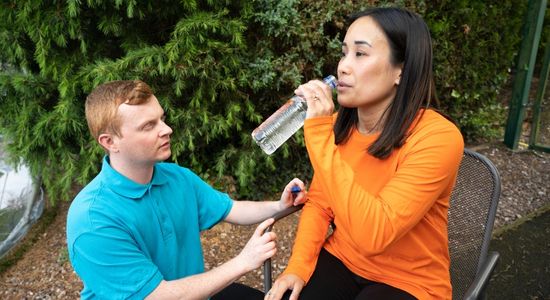Heat exhaustion is often a concern for employers, and the issue isn’t confined to the warmer months. Whilst it’s important to stay safe at work during the summer, heat exhaustion is a year-round issue, particularly in hot working environments, such as bakeries, foundries and kitchens. Therefore, it’s vital to understand its causes and the risks it can pose to you and your team.
In this blog, we’ll provide key insights into heat exhaustion, its effects, the preventative measures you can apply consistently throughout the year to protect your wellbeing, and how first aid training can help you act quickly and confidently, should the need arise.
What is heat exhaustion?
Heat exhaustion is a heat-related medical condition that occurs when the body becomes overheated due to prolonged exposure to high temperatures, often coupled with inadequate fluid intake.
It typically develops when the body's cooling mechanisms, such as sweating, become overwhelmed, leading to an inability to regulate internal temperature effectively.
Causes of heat exhaustion
In the workplace, various factors contribute to heat exhaustion. Understanding these causes is crucial to mitigate the risks associated with heat-related illnesses.
High air temperatures
High air temperatures pose a significant risk in creating an environment where the body struggles to deal with heat efficiently. Higher temperatures increase the likelihood of heat exhaustion, especially if you’re exposed to such conditions for a prolonged period.
Humidity
Humidity levels also play a role, as high humidity reduces the ability of sweat to evaporate from the skin. The cooling effect of evaporation of sweat from the skin is one of the main ways the body can cool itself.
Combining high humidity with elevated temperatures heightens the strain on the body, thereby increasing the risk of heat exhaustion.
Strenuous physical activity
Strenuous physical activity generates internal heat and raises the body's temperature. Engaging in intense work without adequate breaks elevates the risk of heat-related illnesses.
Work clothing
While it's essential to wear the right clothing for work, sometimes the Personal Protective Equipment (PPE) required for certain tasks traps warm air next to the skin and this raises the worker’s body temperature.
It's useful to consider the risks of overheating and select PPE with appropriate ventilation properties to keep the wearer safe, cool and comfortable while working.
Inadequate work clothing can inhibit the body's natural cooling mechanisms, increasing the likelihood of heat exhaustion.
Lack of acclimatisation
Lack of acclimatisation comes into play when the body isn’t given sufficient time to adapt to environmental conditions.
If you and your team aren’t acclimatised to high temperatures, you’re more vulnerable to heat exhaustion and this can affect your ability to regulate your body temperature.
Dehydration
Insufficient fluid intake combined with factors like sweating and high temperatures reduces your body's ability to cool itself through sweating, increasing the risk of heat-related illnesses.
Almost every bodily function relies on having enough water in the system, so a reduction in fluid intake slows everything down and can be hazardous.
Inadequate breaks
Inadequate breaks or insufficient recovery time whilst working in a hot environment can overwhelm your body's temperature, increasing the risk of heat exhaustion and exhaustion.
Understanding these factors allows employers to enforce effective preventive measures. By addressing workplace conditions, selecting appropriate PPE items, promoting hydration, and ensuring appropriate breaks, you can significantly reduce the risk of heat exhaustion and protect your workforce.
People with pre-existing health conditions, such as cardiovascular or respiratory issues, may be more prone to heat exhaustion and its adverse effects. Recognising these conditions is crucial for managing the risk appropriately.
Gain the necessary skills needed to provide care for heat exhaustion with our 3-day First aid at work course
Learn how to monitor your team, intervene when necessary, and maintain a safe and healthy working environment.
How to prevent causes of heat exhaustion
To prevent common causes of heat exhaustion, you need to adopt measures to reduce exposure to high temperatures and ensure your team stays cool and well-hydrated.
Here are some recommended preventative measures:
Hydration
Ensure you and your team maintain adequate fluid intake throughout the day, especially in hot environments. Water is the best choice, but electrolyte-replenishing drinks can help if sweating is excessive.
Cooling strategies
You must keep cool at work. Take regular breaks in shaded or cool areas to allow the body to cool down. If possible, use fans, air conditioning, or cool towels to support temperature regulation.
Appropriate clothing
Where possible, you and your team should wear lightweight, loose-fitting, and light-coloured clothing to reflect rather than absorb the sun's rays. This helps to keep the body temperature at a more manageable level.
Scheduled breaks
Plan work schedules to include breaks during the hottest parts of the day. This minimises prolonged exposure to high temperatures.
Acclimatisation
Gradually increase the time spent working in hot conditions to allow the body to acclimatise. This helps build a tolerance to heat exhaustion over time.
Limit strenuous activity
Reduce strenuous physical activity during the hottest times of the day. If possible, schedule intense tasks for cooler periods.
Sun protection
Use sunscreen with a high SPF to protect the skin from sunburn, which can aggravate the risk of heat-related illnesses.
Monitor conditions
Stay informed about weather conditions and heat advisories. Adjust work activities accordingly when high temperatures are expected.
Education and training
Provide workers with training on recognising the signs of heat exhaustion and the importance of taking preventive measures.
With temperature-related illnesses, self-awareness can be compromised and often they don’t know how ill they’re getting.
Therefore, it’s important to empower colleagues to monitor one another so they can spot the signs early in each other and take steps to prevent heat exhaustion from developing any further.
Emergency response
Establish protocols for responding to heat-related emergencies. Ensure that workers know how to seek medical assistance promptly if symptoms of heat exhaustion arise.
By enforcing a combination of these preventive measures, you can create a safer working environment, and reduce the risk of heat exhaustion among your workforce.
Symptoms of heat exhaustion
Identifying the symptoms of heat exhaustion is crucial for safeguarding the wellbeing of you and your team. There are several signs to look out for, from mild discomfort to more severe indicators.
One common symptom is heavy sweating, as your body attempts to cool down through the evaporation of sweat on your skin. This can lead to dehydration, increasing the risk of heat-related complications.
You may experience weakness and fatigue as your body redirects blood flow to the skin to dissipate heat, resulting in a temporary drop in blood pressure. This may be accompanied by dizziness and light headedness, while nausea and vomiting are also associated signs.
The digestive system may temporarily shut down as your body prioritises cooling mechanisms over other functions, while it’s also common to experience muscle cramps, stemming from the loss of electrolytes through sweating.
In some cases, the skin may become cool and moist, and your pulse rate may increase. This is indicative of your body's struggle to regulate its temperature.
Recognising these symptoms is crucial for the wellbeing of yourself and others, especially in hot environments. Act promptly by moving to a cooler environment, rehydrating, and resting to prevent the progression of heat exhaustion to more severe conditions like heat stroke.
Understanding how to recognise and address symptoms of heat exhaustion
Training your workers to recognise the symptoms of heat exhaustion is crucial.
Identifying signs early allows for prompt intervention, reducing the progression of heat-related illnesses to more severe conditions such as heatstroke. This can significantly reduce the impact on an individual's health and potentially save lives.
Secondly, awareness of heat exhaustion symptoms fosters a proactive safety culture within the workplace. When your team is trained to identify signs of heat stress, they become active participants in their wellbeing and that of others. This not only enhances the overall health and safety of the workforce but also promotes a sense of responsibility and mutual care.
Moreover, by understanding and recognising the symptoms of heat exhaustion, workers can take preventive measures before the condition worsens. This may include seeking shade, staying hydrated, and adjusting work activities.
How our approach to first aid training can help you treat heat exhaustion in an emergency
Training workers to recognise the symptoms of heat exhaustion is a fundamental component of a comprehensive health and safety strategy.
Our 3-day First aid at work course includes expert tuition geared towards helping learners develop the ability to administer first aid provision for those suffering from heat exhaustion.
This interactive training helps you recognise the important symptoms associated with dehydration and heat exhaustion and apply appropriate treatment for casualties. Learners are also provided with the necessary skills and knowledge to confidently apply first aid if the condition escalates into heat stroke.
There’s no such thing as a ‘one-size-fits-all’ approach to learning. The instruction of the course can be altered to meet your preferences.
Whether you’d prefer an interactive delivery or a less hands-on approach, we’ll deliver a comprehensive course that’ll help you treat heat exhaustion accurately and confidently.
Topics: FAW Industry




